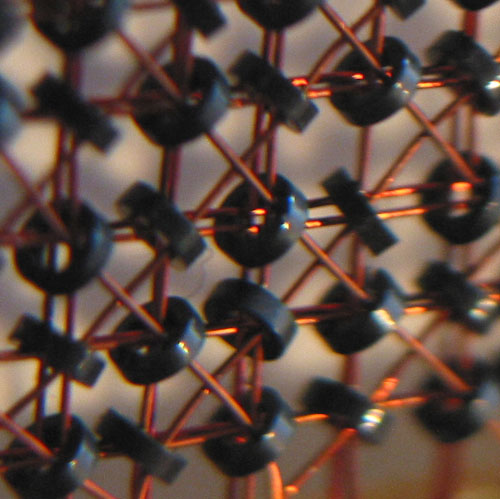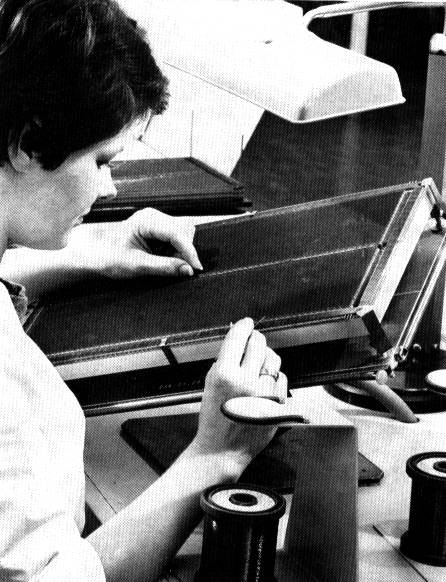
Experimental images showing two small domains with magnetic orientation up (white) and down (black). Each laser pulse reverses the direction repeatedly.
Posted on 02/16/2012 8:16:39 PM PST by neverdem

An ultrashort heat pulse can predictably flip a bit in a magnetic memory like the one in your hard drive. The surprising effect could ultimately lead to magnetic memories hundreds of times faster and more energy efficient than today's hard drives. It also provides a way to control the direction in which a bit is magnetized without applying something else that has a direction, such as a magnetic field.
Two decades ago you could boast that your new desktop computer had a hard drive that could hold 20 megabytes, or 160 million bits, of information. Now, laptops come with disks as big as 1 terabyte—a 50,000-fold increase in capacity. But larger storage capacity must go hand in hand with the ability to read and write bits faster.
Each bit in a magnetic recording medium is in fact a nanometer-sized patch or "domain" that can be magnetized in either of two directions—say, up and down—to encode a 0 or a 1. That information is read out by the read head, a tiny electromagnet that passes over the rotating disk and measures each domain's orientation. The same head also writes the information to the disk by applying a magnetic field that flips a bit's orientation. But the traditional electromagnetic read head struggles to keep up. For a while now, the time needed to write one bit has been stuck at about 1 nanosecond, limiting the rate of data transfer.
That's one reason researchers are searching for much faster ways to flip magnetic bits. One possibility is to heat up the magnetic domain while applying the magnetic field, making the bit easier to flip. But now Alexey Kimel, a physicist at Radboud University Nijmegen in the Netherlands, and colleagues have found that heat alone might do the trick. An ultrashort laser pulse causes a rise in temperature that in a couple of thousandths of a nanosecond controllably switches the orientation of the magnetization of an alloy of gadolinium and iron, the researchers report today in Nature Communications.
The odd thing is that the heat pulse has no direction to tell a tiny magnetic domain which way to point. So at first blush, it might seem like a heat pulse alone should produce a random result, sometimes flipping the bit and sometimes not. Instead, the heat pulses flipped the bit back and forth like a light switch with complete predictability. "This was a total surprise to us all," Kimel says.
The key effect lies in the atomic-scale details of the material—in this case iron and gadolinium—placed on alternating sites in a regular pattern called a crystal lattice. Each atom has its own magnetism. In the material, the iron and gadolinium atoms are magnetized in opposite directions. Because gadolinium is more magnetic, the "ferrimagnetic" material as a whole is magnetized in the direction of the gadolinium atoms. If the material were heated slowly, the interaction between atoms would no longer be able to keep all the spins neatly aligned, and the magnetic order would disappear in a process somewhat like the melting of a solid, Kimel says.
But in the current experiment, laser light heats up the gadolinium-iron alloy so incredibly fast—in 1/10,000 of a nanosecond—that at first only the iron atoms lose their mass orientation. The gadolinium atoms react more slowly in losing their magnetization. And once the iron atoms get hot enough and are free to pivot around, they prefer to align in the same direction as the gadolinium atoms. Then, as the material quickly cools and the orientations of the atoms freeze up, the iron and gadolinium atoms again prefer to point in opposite directions. But this time, it's the slow-cooling gadoliniums that flip leading to a predictable overall reversal in the material's magnetization. "We do not understand the full details of this mechanism yet," says Thomas Ostler of the University of York in the United Kingdom, who performed calculations on the ferrimagnetic material.
The observed effect could make magnetic recording media like hard drives hundreds of times faster. "Writing bits this way is potentially much more energy efficient, because there is no longer a need for energy-consuming electromagnets," Kimel says.
Of course, the new technique must compete against others. In recent years, researchers have shown that they can flip magnetic bits with oscillating electric fields or currents of electrons all spinning the same way—strategies that involve physical entities with directions.
"These techniques will probably be used in commercial products sooner, because scientists and engineers have already been working on them for a couple of years," says physicist Bert Koopmans of Eindhoven University of Technology in the Netherlands, who was not involved in the research. "Personally, I don't see this laser-induced bit switching incorporated in hard drives any time soon, since the necessary laser systems are now still 1-meter long and hard to integrate." Still, Koopmans says, the new technique may find niche applications, such as ultrafast buffer memories, meant to store information in applications that use fast, optical signals, for which speed is more important than miniaturization.
Somewhat related:
SSDs have a ‘bleak’ future, researchers say
http://www.computerworld.com/s/article/9224322/SSDs_have_a_bleak_future_researchers_say
Ping
Thanks for the link.

Is this totally different from HAMR?

Writes magnetically, reads optically. Common name Mini Disc. Later recycled into the PSP UMD game carts.
I’ve often wondered why they never put two or four heads on a single hard drive platter. You would essentially have two or four hard drives in one(depending on the number of heads. Then each head would be sequentially synchonized so that one head would read/write one bit, the next head the next bit, and so on. So if you have 4 heads, there would be 4 separate tracks each reading and writing slightly out of phase. You would quadruple your speed with 4 heads without increasing the RPMs of the platter. If a hard drive had 4 platters and 4 heads per platter, you’d have 16 times the speed.
It’s hard to believe we were using that stuff 30 years ago.
I recently bought a SSD for my primary home machine, and it’s incredible. The boost in performance was just amazing. I never knew how crappy the ‘old’ hard disks were until trying out one of these. From the time I hit the power button, around 5 or 6 seconds later, I’m logged in and using the computer. All apps that use the disk a lot also got a dramatic boost in performance.
The disk actually increased the “Windows Experience Index” for Windows 7 on my computer to a 7.4 out of 8.0.
Not only that, but the seamstress
doesn't look the least bit Chinese.

Great, we now get to watch trash faster, and we can store
more of it at a faster rate!
uhm, no.
Get rid of plates and go SSD or crystalline type structures.
flpping something on a record player isn’t going to make it faster just tighter.
Great shades of the past! My first career field in the AF was maintaining communications gear (tape/card punches/readers) and the “brains” of the show had 512 bytes of core memory. Neatly packaged in a box about the size of an attache case.
Thanks neverdem. Kilobyte, megabyte, gigabyte, terabyte, petabyte, exabyte, zettabyte, yottabyte...
SSDs use less power than HDD (and will continue to), weigh less (and will continue to for some time, possibly indefinitely), and remain speedier (give or take manufacturer), which probably points to SSDs in all mobile technology in the short and middle term (at least), and HDD capacity increasing and cheaper in fixed boxes, such as home vid, desktop PCs, and ‘the cloud’.

Disclaimer: Opinions posted on Free Republic are those of the individual posters and do not necessarily represent the opinion of Free Republic or its management. All materials posted herein are protected by copyright law and the exemption for fair use of copyrighted works.